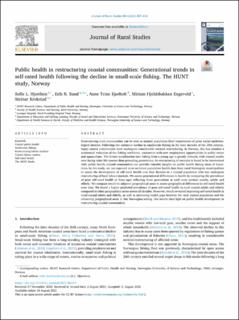| dc.contributor.author | Hjorthen, Sofie Lauvås | |
| dc.contributor.author | Sund, Erik | |
| dc.contributor.author | Kjørholt, Anne Trine | |
| dc.contributor.author | Engevold, Miriam Hjeldsbakken | |
| dc.contributor.author | Krokstad, Steinar | |
| dc.date.accessioned | 2022-03-04T09:13:05Z | |
| dc.date.available | 2022-03-04T09:13:05Z | |
| dc.date.created | 2021-08-30T16:11:38Z | |
| dc.date.issued | 2021 | |
| dc.identifier.citation | Journal of Rural Studies. 2021, 88 307-316. | en_US |
| dc.identifier.issn | 0743-0167 | |
| dc.identifier.uri | https://hdl.handle.net/11250/2983020 | |
| dc.description.abstract | Restructuring rural communities can be seen as natural population level experiments of great social epidemiological interest. Following the extensive decline in small-scale fishing in the later decades of the 20th century, many coastal communities have undergone considerable societal restructuring. In Norway, this has entailed a substantial reduction of the fishing workforce, concurrent with new employment opportunities in public sector and aquaculture. The former socialization into fishing from a young age is greatly reduced, with coastal youths now facing other life courses than preceding generations. As restructuring of societies is found to be intertwined with public health, coastal communities can provide valuable insights on public health during times of transitions. In this study, we use repeated cross-sectional population health data from rural Norwegian municipalities to assess the development of self-rated health over four decades in a coastal population who has undergone restructuring of local labour markets. We assess generational differences in health by comparing the prevalence of poor self-rated health at three ages reflecting three generations at each cross section: youths, adults and elderly. We compare results to adjacent geographical areas to assess geographical differences in self-rated health over time. We found a higher predicted prevalence of poor self-rated health in rural coastal adults and elderly compared to other geographical areas across all decades. However, trends revealed improving self-rated health in rural coastal adults and elderly, as well as narrowing health gaps between the rural coastal population and the remaining geographical areas in this Norwegian setting. Our results shed light on public health development in restructuring coastal communities. | en_US |
| dc.language.iso | eng | en_US |
| dc.publisher | Elsevier | en_US |
| dc.rights | Navngivelse 4.0 Internasjonal | * |
| dc.rights.uri | http://creativecommons.org/licenses/by/4.0/deed.no | * |
| dc.title | Public health in restructuring coastal communities: Generational trends in self-rated health following the decline in small-scale fishing. The HUNT study, Norway | en_US |
| dc.type | Peer reviewed | en_US |
| dc.type | Journal article | en_US |
| dc.description.version | publishedVersion | en_US |
| dc.source.pagenumber | 307-316 | en_US |
| dc.source.volume | 88 | en_US |
| dc.source.journal | Journal of Rural Studies | en_US |
| dc.identifier.doi | 10.1016/j.jrurstud.2021.08.013 | |
| dc.identifier.cristin | 1929858 | |
| cristin.ispublished | true | |
| cristin.fulltext | original | |
| cristin.qualitycode | 2 | |

